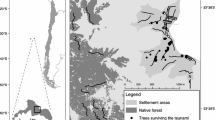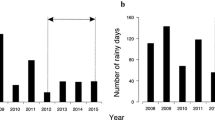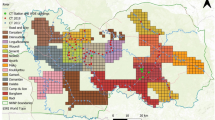Abstract
Foreseeing faunal responses to fire is a challenging issue, due to the context-dependent effects of fire. Although previous studies have registered declines in the abundance of vertebrates, particularly small mammals, following changes in fire regimes, the mechanisms driving these changes are still poorly understood. Hence, we investigated the effects of a severe fire on the abundance, survival, and body condition of a semelparous didelphid (Gracilinanus agilis) inhabiting one of the largest Cerrado remnants in the Triangulo Mineiro region. Using a before–after approach, G. agilis individuals were monitored from 2011 to 2016 through monthly live-trapping sessions. Gracilinanus agilis population followed repeated oscillations every year, with marked declines in abundance after the mating season, irrespective of the 2014´s fire. Although fire reduced population size, it did not lead to a precipitous decline in G. agilis abundance. Survival rates were not affected by fire; instead were determined by the sex and breeding status of individuals. The fire caused a decrease only in female body condition, which resulted in a reduced length of the breeding season and a lower number of juveniles following the disturbance. Our results support the contention that fire affects small mammals indirectly, mainly through its effects on recruitment. The observed weak fire effects on the population level seem to be associated with the less sensitive dynamics of fast-living species. Hence, we emphasize the need to investigate the mechanisms driving faunal responses to fire, especially considering the recent changes in fire regimes and the role of life histories on species responses.





Similar content being viewed by others
Data availability
The raw data that support the findings of this study are available from the corresponding author, Natália Oliveira Leiner, upon request.
References
Andersen AN (2021) Faunal responses to fire in Australian tropical savannas: Insights from field experiments and their lessons for conservation management. Divers Distrib 27:828–843. https://doi.org/10.1111/ddi.13198
Andersen AN, Woinarski JCZ, Parr CL (2012) Savanna burning for biodiversity: Fire management for faunal conservation in Australian tropical savannas. Austral Ecol 37:658–667. https://doi.org/10.1111/j.1442-9993.2011.02334.x
Banks SC, Knight EJ, McBurney L et al (2011) The effects of wildfire on mortality and resources for an arboreal marsupial: resilience to fire events but susceptibility to fire regime change. PloS One, v. 6, n. 8, e22952. https://doi.org/10.1371/journal.pone.0022952
Banks-Leite C, Pardini R, Boscolo D et al (2014) Assessing the utility of statistical adjustments for imperfect detection in tropical conservation science. J Appl Ecol 51:849–859. https://doi.org/10.1111/1365-2664.12272
Bond WJ, Parr CL (2010) Beyond the forest edge: ecology, diversity and conservation of the grassy biomes. Biol Conserv 143:2395–2404. https://doi.org/10.1016/j.biocon.2009.12.012
Bowman DMJS, Balch JK, Artaxo P et al (2009) Fire in the earth system. Science 324:481–484. https://doi.org/10.1126/science.1163886
Briani DC, Palma ART, Vieira EM, Henriques RPB (2004) Post-fire succession of small mammals in the Cerrado of central Brazil. Biodivers Conserv 13:1023–1037. https://doi.org/10.1023/B:BIOC.0000014467.27138.0b
Brigatti E, Vieira MV, Kajin M et al (2016) Detecting and modelling delayed density-dependence in abundance time series of a small mammal (Didelphis aurita). Sci Rep 6:1–8. https://doi.org/10.1038/srep19553
Burnham KP, Anderson DR (2002) Model selection and multimodel inference: a practical information-theoretic approach. Colorado State University, Colorado
Camargo NF, Ribeiro JF, Camargo AJA, Vieira EM (2013) Diet of gracile mouse opossum Gracilinanus agilis (Didelphimorphia: Didelphidae) in a neotropical savanna: intraspecific variation and resource selection. Acta Theriol 59:183–191
Carbone LM, Tavella J, Pausas JG, Aguilar R (2019) A global synthesis offire effects on pollinators. Glob Ecol Biogeogr 28:1487–1498. https://doi.org/10.1111/geb.12939
Corbett LK, Andersen AN, Müller WJ (2003) Terrestrial vertebrates. In: Andersen AN, Cook GD, Williams RJ (eds) Fire in tropical savannas: the Kapalga experimente. Springer, New York, pp 126–152
De Marco PJ, Villén S, Mendes P et al (2020) Vulnerability of Cerrado threatened mammals: an integrative landscape and climate modeling approach. Biodivers Conserv 29:1637–1658. https://doi.org/10.1007/s10531-018-1615-x
Driscoll DA, Lindenmayer DB, Bennett AF et al (2011) Fire management for biodiversity conservation: key research questions and our capacity to answer them. Biol Conser 143:1928–1939. https://doi.org/10.1016/j.biocon.2010.05.026
Durigan G (2020) Zero-fire: not possible nor desirable in the Cerrado of Brazil. Flora 268:151612. https://doi.org/10.1016/j.flora.2020.151612
Ellis RD, McWhorter TJ, Maron M (2012) Integrating landscape ecology and conservation physiology. Landscape Ecol 27:1–12. https://doi.org/10.1007/s10980-011-9671-6
Fair JM, Whitaker SJ (2008) Avian cell-mediated immune response to drought. Wilson J Orn 120:813–819. https://doi.org/10.1676/06-052.1
Fernandes FR, Cruz LD, Martins EG, dos Reis SF (2010) Growth and home range size of the gracile mouse opossum Gracilinanus microtarsus (Marsupialia: Didelphidae) in Brazilian Cerrado. J Trop Ecol 26:185–192. https://doi.org/10.1017/S0266467409990526
Ferreira MS, Kajin M, Cerqueira R, Vieira MV (2015) Marsupial population dynamics in a tropical rainforest: intraspecific competition and nonlinear effect of rainfall. J Mammal 97:121–127. https://doi.org/10.1093/jmammal/gyv161
Figueiredo MSL, Fernandez FAS (2004) Contrasting effects of fire on populations of two small rodent species in fragments of Atlantic Forest in Brazil. J Trop Ecol 20:225–228. https://doi.org/10.1017/S0266467403001093
Fisher DO, Johnson CN, Lawes MJ et al (2014) The current decline of tropical marsupials in Australia: Is history repeating? Glob Ecol Biogeogr 23:181–190. https://doi.org/10.1111/geb.12088
Fordyce A, Hradsky BA, Ritchie EG, Di Stefano J (2015) Fire affects microhabitat selection, movement patterns, and body condition of an Australian rodent (Rattusfuscipes). J Mammal 97:102–111. https://doi.org/10.1093/jmammal/gyv159
Frizzo TLM, Bonizario C, Borges MP, Vasconcelos HL (2011) Revisão dos efeitos do fogo sobre a fauna de formações savânicas do Brasil. Oecol Aust 15:365–379
Gamelon M, Gimenez O, Baubet E et al (2014) Influence of life-history tactics on transient dynamics: a comparative analysis across mammalian populations. Am Nat 184:673–683. https://doi.org/10.1086/677929
Gardner AL (2008) Mammals of South America, vol 1: marsupials, xenarthrans, shrews, and bats. University of Chicago Press, Chicago
Geiser F, Stawski C, Doty AC et al (2018) A burning question: what are the risks and benefits of mammalian torpor during and after fires? Conserv Physiol 11:coy057. https://doi.org/10.1093/conphys/coy057.
Gonçalves RVS, Cardoso JCF, Oliveira PE, Oliveira DC (2021) Changes in the Cerrado vegetation structure: insights from more than three decades of ecological succession. Web Ecol 21:55–64. https://doi.org/10.5194/we-21-55-2021
Griffiths AD, Brook BW (2014) Effect of fire on small mammals: a systematic review. Int J Wildland Fire 23:1034–1043. https://doi.org/10.1071/WF14026
Griffiths AD, Brook BW (2015) Fire impacts recruitment more than survival of small mammals in a tropical savanna. Ecosphere 6:art99. https://doi.org/10.1890/es14-00519.1
Hardesty J, Myers R, Fulks W (2005) Fire, ecosystems, and people: a preliminary assessment of fire as a global conservation issue. George Wright Forum 22:78–87
He T, Lamont BB, Pausas JG (2019) Fire as a key driver of Earth’s biodiversity. Biol Rev 94:1983–2010. https://doi.org/10.1111/brv.12544
Hofmann GS, Cardoso MF, Alves RJV et al (2021) The Brazilian Cerrado is becoming hotter and drier. Glob Change Biol 27:4060–4073. https://doi.org/10.1111/gcb.15712
Leahy L, Legge SM, Tuft K et al (2016) Amplified predation after fire suppresses rodent populations in Australia’s tropical savannas. Wildl Res 42:705–716. https://doi.org/10.1071/WR15011
Lebreton JD, Burnham KP, Clobert J, Anderson DR (1992) Modeling survival and testing biological hypotheses using marked animals: a unified approach with case studies. Ecol Monogr 62:67–118. https://doi.org/10.2307/2937171
Legge S, Murphy S, Heathcote J et al (2008) The short-term effects of an extensive and high-intensity fire on vertebrates in the tropical savannas of the central Kimberley, northern Australia. Wildl Res 35:33–43. https://doi.org/10.1071/WR07016
Lindenmayer DB, Blanchard W, McBurney L et al (2013) Fire severity and landscape context effects on arboreal marsupials. Biol Conser 167:137–148. https://doi.org/10.1016/j.biocon.2013.07.028
Lopes GP, Leiner NO (2015) Semelparity in a population of Gracilinanus agilis (Didelphimorphia: Didelphidae) inhabiting the Brazilian cerrado. Mamm Biol 80:1–6. https://doi.org/10.1016/j.mambio.2014.08.004
Macedo J, Loretto D, Vieira MV, Cerqueira R (2006) Classes de desenvolvimento em marsupiais: um método para animais vivos. Mastozool Neotropical 13:133–136
Mendonça AF, Armond T, Camargo ACL et al (2015) Effects of an extensive fire on arboreal small mammal populations in a neotropical savanna woodland. J Mammal 96:368–379. https://doi.org/10.1093/jmammal/gyv038
Milenkaya O, Weinstein N, Legge S, Walters JR (2013) Variation in body condition indices of crimson finches by sex, breeding stage, age, time of day, and year, Conserv Physiol 1:cot020. https://doi.org/10.1093/conphys/cot020
Myers N (2003) Biodiversity hotspots revisited. Bioscience 53:916–917. https://doi.org/10.1641/0006-3568
Peig J, Green AJ (2009) New perspectives for estimating body condition from mass/length data: the scaled mass index as an alternative method. Oikos 118:1883–1891. https://doi.org/10.1111/j.1600-0706.2009.17643.x
Peig J, Green AJ (2010) The paradigm of body condition: a critical reappraisal of current methods based on mass and length. Funct Ecol 24:1323–1332. https://doi.org/10.1111/j.1365-2435.2010.01751.x
Pellegrini AFA, Ahlström A, Hobbie SE et al (2018) Fire frequency drives decadal changes in soil carbon and nitrogen and ecosystem productivity. Nature 553:194–198. https://doi.org/10.1038/nature24668
Pereoglou F, MacGregor C, Banks SC et al (2011) Refuge site selection by the eastern chest-nut mouse in recently burnt heath. Wildl Res 38:290–298. https://doi.org/10.1071/WR11007
Pilastro A, Tavecchia G, Marin G (2003) Long living and reproductive skipping in the fat dormouse. Ecology 84:1784–1792. https://doi.org/10.1890/0012-9658(2003)084[1784:LLARSI]2.0.CO;2
Pivello VR, Vieira I, Christianini AV et al (2021) Understanding Brazil´s catastrophic fires: causes, consequences and policy needed to prevent future tragedies. Perspect Ecol Conserv 19:233–255. https://doi.org/10.1016/j.pecon.2021.06.005
Previtali MA, Meserve PL, Kelt DA et al (2010) Effects of more frequent and prolonged El Niño events on life-history parameters of the Degu, a long-lived and slow-reproducing rodent. Conserv Biol 24:18–28. https://doi.org/10.1111/j.1523-1739.2009.01407.x
Puida DBC, Paglia AP (2015) Primary productivity and the demography of Gracilinanus agilis, a small semelparous marsupial. J Mammal 96:221–229. https://doi.org/10.1093/jmammal/gyu030
R Core Team (2019) R: A language and environment for statistical computing. R Foundation for Statistical Computing, Vienna, Austria. https://www.R-project.org
Reading CJ (2007) Linking global warming to amphibian declines through its effects on female body condition and survivorship. Oecologia 151:125–131. https://doi.org/10.1007/s00442-006-0558-1
Recher HF, Lunney D, Matthews A (2009) Small mammal populations in a eucalypt forest affected by fire and drought. I. Long-term patterns in an era of climate change. Wildl Res 36:143–158. https://doi.org/10.1071/WR08086
Ribeiro JF, Guaraldo A, Nardoto GB et al (2018) Habitat type and seasonality influence the isotopic trophic niche of small mammals in a neotropical savanna. Hystrix 30:30–38. https://doi.org/10.4404/hystrix-00150-2018
Romero LM, Wingfield JC (2016) Tempests, poxes, predators, and people: stress in wild animals and how they cope. Oxford University Press, Oxford
Rosa TF, Camarota F, Zuanon LA et al (2021) The effects of high-severity fires on the arboreal ant community of a Neotropical savanna. Oecologia 196:951–961. https://doi.org/10.1007/s00442-021-04922-x
Rosan TM, Aragão LEOC, Oliveras I et al (2019) Extensive 21st-century woody encroachment in South America’s savanna. Geophys Res Lett 46:6594–6603. https://doi.org/10.1029/2019GL082327
Rossi RC, Leiner NO (2022) Weather, fire and density drive population dynamics of small mammals in the Brazilian Cerrado. J Mammal gyac053. https://doi.org/10.1093/jmammal/gyac053
Sergio F, Blas J, Hiraldo F (2018) Animal responses to natural disturbance and climate extremes: a review. Glob Planet Change 161:28–40. https://doi.org/10.1016/j.gloplacha.2017.10.009
Sheridan JÁ, Bickford D (2011) Shrinking body size as an ecological response to climate change. Nat Clim Change 1:401–406. https://doi.org/10.1038/nclimate1259
Sikes RS (2016) 2016 Guidelines of the American Society of Mammalogists for the use of wild mammals in research and education. J Mammal 97:663–688. https://doi.org/10.1093/jmammal/gyw098
Simon MF, Grether R, de Queiroz LP et al (2009) Recent assembly of the Cerrado, a neotropical plant diversity hotspot, by in situ evolution of adaptations to fire. Proc Natl Acad Sci 106:20359–20364. https://doi.org/10.1073/pnas.0903410106
Speakman JR (2008) The physiological costs of reproduction in small mammals. Phil Trans R Soc B 363:375–398. https://doi.org/10.1098/rstb.2007.2145
Strassburg BBN, Brooks T, Feltran-Barbieri R et al (2017) Moment of truth for the Cerrado hotspot. Nat Ecol Evol 1:3. https://doi.org/10.1038/s41559-017-0099
Swinburn ML, Fleming PA, Craig MD et al (2007) The importance of grasstrees (Xanthorrhoea preissii) as habitat for mardo (Antechinus flavipes leucogaster) during post-fire recovery. Wildl Res 34:640–651. https://doi.org/10.1071/WR07035
Tomkins JL, Radwan J, Kotiaho JS, Tregenza T (2004) Genic capture and resolving the lek paradox. Trends Ecol Evol 19:323–328. https://doi.org/10.1016/j.tree.2004.03.029
Vasconcelos HL, Pacheco R, Silva RC et al (2009) Dynamics of the leaf-litter arthropod fauna following fire in a Neotropical woodland savanna. PLoS One 4:e7762. https://doi.org/10.1371/journal.pone.0007762
Vasconcelos HL, Maravalhas JB, Cornelissen T (2017) Effects of fire disturbance on ant abundance and diversity: a global meta-analysis. Biodivers Conserv 26:177–188. https://doi.org/10.1007/s10531-016-1234-3
Vieira EM (1999) Small mammal communities and fire in the Brazilian Cerrado. J Zool 249:75–81. https://doi.org/10.1111/j.1469-7998.1999.tb01061.x
Whelan RJ (1995) Approaches to population studies. In: Whelan RJ (ed) The ecology of fire. Cambridge University Press, Cambridge, pp 135–150
White GC, Burnham KP (1999) Program MARK: survival estimation from populations of marked animals. Bird Study 46:120–139. https://doi.org/10.1080/00063659909477239
Wingfield JC, Sapolsky RM (2003) Reproduction and resistance to stress: when and how. J Neuroendocrinol 15:711–724. https://doi.org/10.1046/j.1365-2826.2003.01033.x
Woinarski JCZ, Legge S, Fitzsimons JA et al (2011) The disappearing mammal fauna of northern Australia: context, cause and response. Conserv Lett 4:192–201. https://doi.org/10.1111/j.1755-263X.2011.00164.x
Acknowledgements
We thank the students of Laboratório de Ecologia de Mamíferos at Federal University of Uberlândia for their help in data collection and for providing data that allowed writing this manuscript. We are especially grateful to Celine Melo, Natália M. Torres and two anonymous reviewers that provided suggestions that improved manuscript quality. Finally, we thank Instituto de Biologia (INBIO/UFU) and Estação Ecológica do Panga (PES) for providing logistical support.
Funding
This study was financed in part by the Coordenação de Aperfeiçoamento de Pessoal de Nível Superior—Brasil (CAPES)—Finance Code 001. Fundação de Apoio à Pesquisa do Estado de Minas Gerais (PELD APQ-03202–13 and APQ-04815–17) and Conselho Nacional de Desenvolvimento Científico e Tecnológico (CNPq PELD 441225/2016–0 and CNPq PELD 441142/2020–6) also provided financial support.
Author information
Authors and Affiliations
Contributions
Both authors contributed to the study conception and design. Data collection were performed by RCR, and analysis was performed by RCR and NOL. All authors worked on manuscript preparation. Finally, both authors read and approved the final manuscript.
Corresponding author
Ethics declarations
Conflict of interest
The authors declare no conflicting or competing interests.
Research permits and ethics approval
This study followed the guidelines and protocols declared in the American Society of Mammalogists (Sikes 2016) and the ethical principles on animal research as regulations of National Advice of Control and Animal Experimentation (CONCEA/Brazil). All animal experiments were approved by the Ethics Committee on Use of Animals of the Federal University of Uberlândia, Brazil; Reference number 152/13.
Consent to participate
Not applicable.
Consent for publication
Not applicable.
Code
Not applicable.
Additional information
Handling editor: Francesco Ferretti.
Publisher's Note
Springer Nature remains neutral with regard to jurisdictional claims in published maps and institutional affiliations.
Supplementary Information
Below is the link to the electronic supplementary material.
Rights and permissions
Springer Nature or its licensor (e.g. a society or other partner) holds exclusive rights to this article under a publishing agreement with the author(s) or other rightsholder(s); author self-archiving of the accepted manuscript version of this article is solely governed by the terms of such publishing agreement and applicable law.
About this article
Cite this article
Rossi, R.C., Leiner, N.O. Effects of severe fires on the survival and body condition of Gracilinanus agilis in a Cerrado remnant. Mamm Biol 103, 205–214 (2023). https://doi.org/10.1007/s42991-022-00340-5
Received:
Accepted:
Published:
Issue Date:
DOI: https://doi.org/10.1007/s42991-022-00340-5




